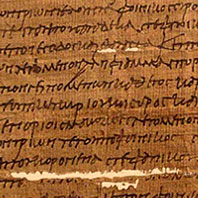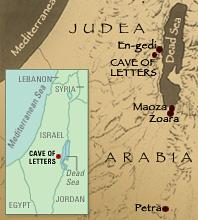|
In 1961, Yoseph Porath, a volunteer on an archeological expedition to what is
now known as the Cave of Letters, along the west coast of the Dead Sea in
Israel, stepped on a wobbly stone deep within the dusty cavern. It proved to be
a giant step for our understanding of Jewish life 2,000 years ago. For beneath
that stone, Yigael Yadin, the expedition's leader, having been alerted by
Porath, discovered a bundle of papyrus scrolls. The cache turned out to be the
valuable personal documents of a Jewish woman named Babatha, who lived and died
in the second century A.D.
Babatha's documents—covering everything from a sale of property to a
petition to the governor, from a court summons to a marriage
contract—don't tell us what she looked like or what she felt or thought.
But they do tell us, by standards of evidence unearthed from early Jewish
history, an enormous amount about her life and times. As Richard Freund, an
archeologist who led an expedition to the cave between 1999 and 2001, writes in
his new book Secrets of the Cave of Letters, Babatha, who owned property
both in Petra (in modern Jordan) and in En-gedi (in modern Israel),
"revolutionized the way that we think about Jewish women in antiquity."
 Born to own
Born to own

Towards the end of the first century A.D., Babatha's father, Simon, settled in
the port town of Maoza at the southern end of the Dead Sea (see map at right). At the
time of Babatha's birth around A.D. 104, Maoza was part of the Nabatean
kingdom. (The Nabateans were Semites of Arab stock who spoke Aramaic, the
lingua franca of that time; their capital was Petra, the spectacular rock-cut
city, which lay about 50 miles south of Maoza.) But in 106, the Roman emperor
Trajan overran the Nabateans and made their land a Roman province, the
Provincia Arabia.
While Babatha thus grew up under the yoke of an occupying power, she belonged,
both by birth and by her two marriages, to a well-off stratum of regional
Jewish society. But she was no aristocrat. As the historian Naphtali Lewis has
written, "However we estimate Babatha's social position because of her wealth,
by no stretch of the imagination can this rustic, illiterate woman be classed
among persons in high places." Nevertheless, she was well-to-do, and judging
from the breadth of languages used in the 35 documents in her archive, as well
as by the legal maneuverings she seemed constantly to be involved in, she was
well educated.

While Babatha may have been illiterate, she was no wallflower.

Babatha inherited land three times in her short life. First, her father Simon
bequeathed a date palm orchard he owned to his wife and, upon her death, to his
daughter. So Babatha may already have been a property owner when she married
her first husband, a Maozan resident named Jesus. By 124, Jesus had left
Babatha a widow with a young son—and left her property he owned in Maoza.
(To learn more about these orchards, see Babatha's Scroll.) Apparently not
one to drown in her sorrows, Babatha married again by 125. Her new husband,
Judanes, lived in Maoza but was originally from En-gedi, where he owned three
date orchards. (He also had another wife, Miriam—polygamy was still
permitted in Jewish life at the time.) When Judanes passed on around 130,
Babatha seized his groves in En-gedi as a surety against a debt that he owed
her.
 Tough customer
Tough customer

This debt is one of many indications that while Babatha may have been
illiterate, she was no wallflower. In fact, she was a shrewd businesswoman who
controlled her own money and fought hard to retain it and her other material
wealth. The documents show that when Judanes's daughter from his first wife got
married, Babatha loaned Judanes 300 denarii (the silver coinage of the Roman
period) toward his daughter's 500-denarii dowry. When, after his death,
Judanes's estate failed to repay this debt or Babatha's own dowry (a widow was
entitled to reclaim her dowry), she took possession of her deceased husband's
En-gedi parcels.
This perhaps brazen act proved fateful. For one thing, it launched a legal
battle over those properties with certain members of Judanes's family, in
particular his first wife Miriam, that would hound Babatha for the rest of her
life. More importantly, her new groves may have brought Babatha to En-gedi just
as the largest Jewish revolt against Roman rule—the Bar-Kokhba rebellion,
also known as the Second Revolt—broke out in the region centered on
En-gedi. The last document in Babatha's archive, a summons, is dated the 19th
of August in the year 132, the very year that the rebellion began.
Scholars surmise that Babatha either joined the revolt as a political
sympathizer (as Yadin thought), or that she unwittingly got caught up in events
during a possible visit to Judanes's orchards in En-gedi (as Freund thinks).
Judanes's first wife Miriam had a family connection to a man named Yehonathan,
who was thought to have been the rebel leader Bar-Kokhba's commander in
En-gedi. Freund hypothesizes that when the outbreak of the rebellion made life
in En-gedi dangerous, Miriam, despite having differences with Babatha over
Judanes's land, may have arranged through Yehonathan to send Babatha to the
relative safety of the cave. Miriam's daughter by Judanes, a young woman named
Shelamzion, may have been close to Babatha and even accompanied her to the
cave, for Shelamzion's marriage contract and other important documents were
found in Babatha's archive.
 The end
The end

For whatever reason, Babatha appears to have ended up in the Cave of Letters in
132, a fugitive from Roman legions who went on to brutally suppress the
rebellion, killing what may have been nearly 600,000 Jews. No doubt she planned
to retrieve the documents she stored in a pit in the Cave of Letters and return
to her prosperous life in Maoza and En-gedi, but she apparently died before she
could do it.
Was she enslaved or murdered by Roman soldiers, who had pitched a camp on the
cliff above the cave to keep an eye on the insurgents they knew were hiding out
there? Did she die of starvation in the cave? Indeed, were her remains among
those found by another volunteer on Yadin's expedition in the so-called Niche
of Skulls (see Stumbling Upon a Treasure)? We'll likely never know. All we do
know is that her precious personal documents lay undisturbed for over 1,800
years, before their serendipitous discovery by Yoseph Porath in 1961.


| 

Containing 35
separate papyrus scrolls, Babatha's archive is the largest single collection of
ancient documents ever found in the Holy Land. See Babatha's Scroll for a
closer look at the above document, a registration of four date orchards she
owned.

| |

The Roman Empire engulfed the area
around the Dead Sea, including Babatha's home village of Maoza, when Babatha
was thought to have been about two years old.

| |

Did business with her date-palm groves in
En-gedi lure Babatha to that nucleus of Jewish dissent just as the Second
Revolt was commencing? Scholars think it quite possible.

| |
|

